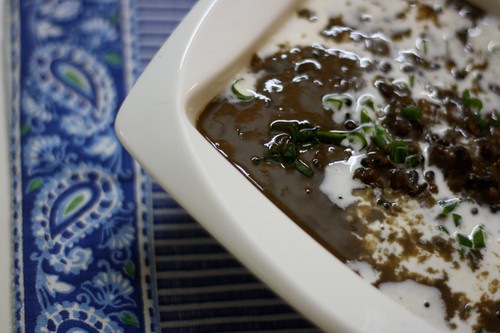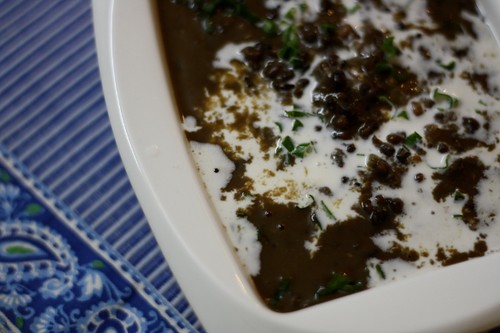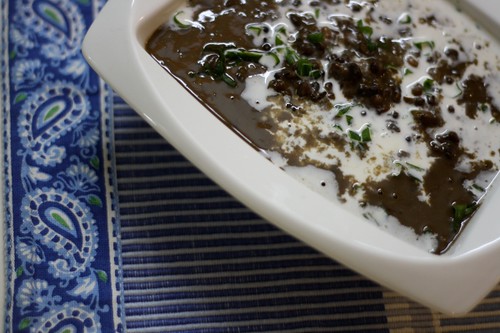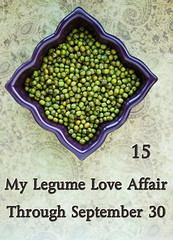
Urad sabat is whole un-husked black gram dal(urad/udad/udid dal). It is nutritious, packed with energy and rich in proteins. When allowed to simmer over a long period of time, it tends to achieve a slightly slimy and thick consistency. Characterized by it's beautiful earthy flavor and a rich brown color, this dal is the queen of slow cooking! And you know just how good slow cooked food tastes...... every little lentil in this dish is given enough time and love to ripen and dissolve into perfection.
I remember seeing huge cauldrons of kali dal gently simmering away on a log fire at a dhaba in Delhi. Perfect, bellywarming food on a nippy December afternoon. Left outside to cook over a log fire for over 12 hours, the dal has an unmistakable aroma and fragrance which you just cannot reproduce with your gas or electric stove. All that soot,smoke and the fruity wooden logs flavor the food in a unique way. Visits to the village where my grand parents made their home reminds me of the food - it had the same fantastic taste and smelled so good. It was partly because of the freshness of the ingredients and also because ajji (My dad's mother) used to cook over a vole or a small log fire. And of course a whole lotta love that she put into it. :)

Don't be overwhelmed by the long cooking hours for this dish. As the efforts are well rewarded even by using your pressure cooker and reducing the cooking time by a great deal. The dal is fragrant and hearty and tastes oh so good with phulkas or rotis.
This recipe is from a book on Punjabi Cooking by Premjit Gill that I found in our attic. It was first printed in 1986! So I'm guessing nothing has changed about the way this beautiful lentil is cooked as most recipes that Google brought back were roughly the same. Although I did modify the recipe a wee bit after I was influenced by other recipes that I read and also some secrets that my neighbor shared with me.
Be forewarned that you only venture into making this dish when you have lots of time on hand. Not active cooking time, but you know the "let it simmer till it cooks down to a beautiful lush consistency" time. This dish took waaaaay longer than what the recipe promised. But it wasn't like I was slaving over it or anything. I just had to check on it occasionally to make sure that there was enough water to keep it from burning and sticking to the bottom. That reminds me - you have to use a thick bottomed vessel for this one.

I'm sending this recipe across to the very talented author, Sia of the gorgeous food blog - Monsoon Spice for the 15th helping of the MLLA (My Legume Love Affair) event. This event was started by Susan who has a fantastic blog space dedicated to her beautifully thought out recipes and pictures.

On to the recipe. Please look at the notes section for additional tips.
Recipe
Ingredients
For the dal :
1 cup urad sabat/ udad saboot/ whole un-husked black gram dal
1 tsp salt
1 inch piece of ginger, chopped fine
8 cloves of garlic, chopped fine or crushed
1 large onion chopped fine
10 cups of water
1/2 tsp of red chilli powder
1/2 tsp of turmeric powder
1/2 tbsp ghee
For the tarka
3 tbsps of butter/ghee
1 medium sized onion, chopped fine
1 medium tomato grated
1/2 tsp of garam masala
1/2 tsp cumin seeds
1/2 inch piece of ginger grated
3 green chillies chopped
4 tbsps of cream for a final flourish! (It's optional but it won't taste the same without it)
Method
Clean, wash and boil the dal in 10 cups of water. When boiling add the salt, ginger, garlic, onion, red chilli and turmeric powder and ghee. Cover and pressure cook for 1/2 hour. Then let the pressure drop. Uncover and allow to simmer on a low fire while you prepare the tarka.
Tarka
Heat the ghee/butter, add the ginger,chopped onion, garam masala, cumin seeeds and fry till light brown. Add green chillies to the simmering dal. Cook another 1/2 hour or until a thick consistency is reached. Serve hot with yogurt, plain rice, parathas or phulkas.
Notes : Here are my modifications to the recipe. The recipe didn't call for it but my neighbor was horrified that it didn't. "You have to soak it or it won't cook!" - the urad was soaked overnight for 10 hours. I then pressure cooked the dal for nearly an hour instead of the recommended half hour. And the simmering to reach the right consistency took another hour. A medium sized tomato was grated and added to the tarka to cut through the dal. This recipe makes a LOT of dal. Serves eight people, so you can easily halve the recipe if you need to.


I like the slices of the photographs that teases us :)
ReplyDeletedal looks so creamy....surely will try this delicious dal...
ReplyDeleteOh WOw!!! Looks gorgeous..i m drooling here!!!
ReplyDeleteThank u shwetha,for stopping by and passing a lovely comment...U have cute space with wonderful recipes..Daal looks awesome!!!Following you dear..
ReplyDeleteHappy blogging!!!
Hi Shwetha.....
ReplyDeleteWow... You have such a lovely space .. New Here... Landed from MLLA15 comments thread...
Dal Makhani is my favourite... and I love to cook it... Totally agree.. Its just aromatic & wonderful when this black urad cooks slowly in the gravy.
Do sneak a peek in my blog too when time permits..
Will see you often...
Hi shwetha,
ReplyDeleteFirst time here.Nice clicks & yummy recipe.Do visit my blog when u find time
You just described this dal perfectly. So simple yet so full of flavour and texture. NO wonder its a favourite with everyone.
ReplyDeleteyou have a nice blog.you can visit my blog view my recipes and give ur comments.
ReplyDeleteHi Shweta
ReplyDeleteGreat blog!!
Can you please do me favour? I have been looking for a chole bhature recipe from Premjit Gill's book, which I lost couple of years back..:-(
Cant seem to find that book anywhere now.
Can you please email me this recipe (of chole and bhature) if you still have this wonderful book? my email is arvindbajaj@hotmail.com
Thanks heaps
Arvind